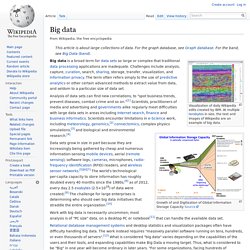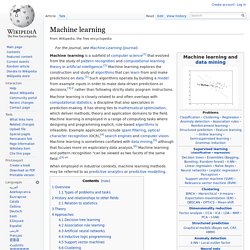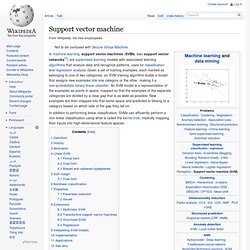

Big data. Visualization of daily Wikipedia edits created by IBM.

At multiple terabytes in size, the text and images of Wikipedia are an example of big data. Growth of and Digitization of Global Information Storage Capacity Source. Machine learning. Machine learning is a subfield of computer science[1] that evolved from the study of pattern recognition and computational learning theory in artificial intelligence.[1] Machine learning explores the construction and study of algorithms that can learn from and make predictions on data.[2] Such algorithms operate by building a model from example inputs in order to make data-driven predictions or decisions,[3]:2 rather than following strictly static program instructions.

Machine learning is closely related to and often overlaps with computational statistics; a discipline that also specializes in prediction-making. It has strong ties to mathematical optimization, which deliver methods, theory and application domains to the field. Support Vector Machines. In machine learning, support vector machines (SVMs, also support vector networks[1]) are supervised learning models with associated learning algorithms that analyze data and recognize patterns, used for classification and regression analysis.

Given a set of training examples, each marked as belonging to one of two categories, an SVM training algorithm builds a model that assigns new examples into one category or the other, making it a non-probabilistic binary linear classifier. An SVM model is a representation of the examples as points in space, mapped so that the examples of the separate categories are divided by a clear gap that is as wide as possible. New examples are then mapped into that same space and predicted to belong to a category based on which side of the gap they fall on.
Definition[edit] Welcome to Apache™ Hadoop®!